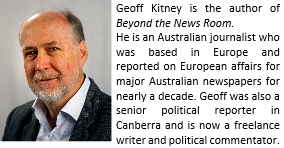In Australia the clarion call of ‘Take back control’ has become the war cry of a re-energised republican movement. Brexiters are not amused, writes Geoff Kitney.
“Reclaim out sovereignty! Take back control”. Those were the clarion rallying calls of the Brexit crowd, inspired by the belief that, by its membership of the European Union and being subject to the decisions of the EU, Britain was a lesser nation, not in control of its own destiny.
Those phrases resonated with Britons who believed that they had a system of government that was capable of ensuring that the nation could fend for itself and no longer compromise its sovereignty by having to look to another capital in another country for the authority to make its laws.
Those same phrases are now being heard on the other side of the world but this time Britain is the villain.
In Australia, “reclaim our sovereignty” has become the war cry of a re-energised republican movement.
Australia has never completely severed it historical ties to its colonial power – Great Britain.
Queen Elizabeth II, from her palaces in Britain, commands as the head of state of Australia, 120 years after Australia became an independent nation.
There has been a persistent longing in Australia for that final tie to be cut but never the collective will to do it.
There is a great irony here: Those Australians who were the most vocal backers of Brexit – right-wing conservatives – are the most entrenched opponents of republicanism, of sticking with a foreign head-of-state. The centre-left, which backed the Remain campaign, are the loudest advocates of full sovereignty for Australia.
For the most part, the republican debate is a background issue in Australian politics, behind the more urgent issues of the daily running of the country.
But, in the past few days, the republican debate has been at the top of the news agenda, replacing briefly the intensifying battle with Covid-19 as the most talked about issue.
The trigger has been the release of secret papers – the so-called Palace Letters – relating to the most serious constitutional crisis in Australian history, the sacking on November 11, 1975, of an elected government by the Governor-General, the Queen’s representative in Australia.
The High Court of Australia recently ruled that Australian citizens had the right to have revealed to them all the secret correspondence between the Governor-General, Sir John Kerr, and Queen Elizabeth from the period leading up to the sacking of the government of Labor Prime Minister Gough Whitlam. The documents had been held under lock and key for 45 years since the Whitlam sacking.
Republicans had long suspected that the reason these important historical documents had been kept secret was because they might reveal that the Queen had played a direct hand in the dismissal. They had demanded the release of the papers to allow the public to know the complete story of what was the most divisive event in Australian political history, an event which at the time took Australia as close as it has ever been to widespread civil unrest.
When the bombshell event took place a few days ago it turned out to be something less than a reverberating shock. The papers revealed no direct instruction from the Queen to Kerr. On the contrary, they revealed that Kerr deliberately avoided giving advance warning to the Queen of his imminent intention to dismiss the Whitlam government. His letters revealed that he feared damaging the standing of the Monarchy in Australia if he had done so.
However, the papers did reveal murky elements to the affair.
The correspondence showed that Kerr kept the Queen, via her private secretary Sir Martin Charteris, intimately informed about the details of the constitutional crisis right up to the moment he decided to order the Whitlam Government’s dismissal.
The crisis was triggered when the conservative Opposition parties moved to block the passage through Parliament of the leftist Labor Government’s budget, thus threatening the ability of the government to govern.
The Whitlam government had presided over a deep economic crisis in the wake of the 1974 global oil shock and had used highly unconventional means to try to fund government programs, including borrowing money from mysterious Middle Eastern financiers.
Under the Australian system, budget bills have to be passed by both the House or Representatives and the Senate. There are different voting systems for the two houses of Parliament and the Opposition, at that time, had control of the Senate and used that control to reject the budget.
There was deep disagreement at the highest levels about how such a deadlock should be resolved. Kerr sought advice from the Chief Justice of the High Court as to whether he had the power under the Constitution to dismiss the government and order a general election. The Chief Justice, a former Conservative politician, controversially advised him that he did, despite top legal authorities advising that he did not.
The formerly secret correspondence between the Governor-General and the Queen revealed that Kerr reported the Chief Justice’s advice to Charteris, as the Queen’s top adviser. Charteris advised that his view was that Kerr did have the power to dismiss the government. Within days, Kerr announced that he had sacked Whitlam and called a general election.
The correspondence showed that Kerr kept the Queen, via her private secretary Sir Martin Charteris, intimately informed about the details of the constitutional crisis right up to the moment he decided to order the Whitlam Government’s dismissal.
The correspondence reveals beyond any doubt that Kerr corresponded with Buckingham Palace as an ambassador in a foreign country would correspond to his home capital. Kerr reported to the Queen via Charteris on every aspect of Australian domestic political affairs.
This was not surprising. Under the Constitution, he was the Queen’s eyes and ears in her Australian domain.
The response to the release of the secret correspondence has been to re-open the never- properly-healed wounds of the constitutional crisis.
“The head of state of a foreign power had a part in our prime minister’s sacking,” one commentator said. “Whatever spin monarchists put on the situation, the fact remains that Australia’s Governor-General, holder of an office with the power to appoint the prime minister and suspend parliament, sought advice from the servants of a foreign country – a country with its own interests that align only partially with the interests of Australia’s – before sacking our elected prime minister. It is clear from the correspondence that the Palace sought to reassure Kerr about his plan to dismiss the government.”
Since the release of the correspondence the Palace has not sought to deny or downplay this interpretation. Australian opponents of this interpretation argue that the letters prove that the Queen had no prior knowledge of Kerr’s decision to dismiss the Whitlam government, nor was there any evidence she gave her approval to such a course of action.
Australian monarchists have risen to the defence of the Queen and the system.
They argue that the fact that Kerr did not tell the Queen of his decision to go ahead and sack the government reveals that the ultimate decision was taken by an Australian, not a foreigner. They also argue that the letters confirm that current constitutional arrangements which allow the Governor-General to dismiss a government provides a “safety valve” to resolve parliamentary impasses over budget bills.
Public opinion, prior to the release of the correspondence, showed a majority in favour of Australia becoming a republic. A majority of Australians believe Australia would be a more sovereign nation with an Australian head-of-state. Republicans expect this majority to grow as a consequence of the release of the documents.
However, there are deep divisions among republicans about what form an Australian republic should take. These divisions – between those who believe an Australian President should be elected by the Parliament and those who believe the head of state should be chosen by the people by a national vote – scuttled a 1999 referendum on the question of whether Australia should become a republic. The proposal put then was for a figure-head President to be chosen by the parliament. Republicans who wanted a popularly elected head-of-state ultimately campaigned for a “no” vote and the proposal lost 55 per cent to 45 per cent.
The issue of what form of republic Australia should become still divides republicans.
Whether the release of the Palace letters unlocks this deadlock remains to be seen. Had there been clear cut evidence that the Queen gave Kerr her imprimatur to sack the government, there might have been a decisive shift.
Taking back control sounds like a great idea. But, as Brexit and the vast uncertainty that now exists as a consequence of the decision has shown, doing it is a lot more complicated than shouting it from the rooftops.
Headline image credit: MattiaATH/Shutterstock.com






